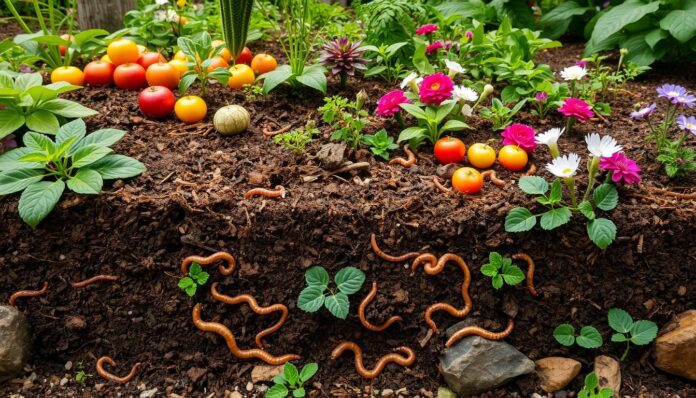What if the key to a sustainable future lies in the earth beneath our feet? We face challenges like climate change and environmental degradation. Permaculture soil regeneration is a vital practice for creating resilient ecosystems. It combines permaculture design with regenerative gardening techniques.
By doing this, individuals can promote soil health, biodiversity, and ecosystem balance. This helps create a more sustainable food system. To learn more, visit permaculture soil regeneration. Discover the benefits of sustainable farming practices and organic gardening techniques.
Permaculture soil regeneration focuses on soil health and organic methods. It aims for ecosystem balance and resilience. This practice is linked to regenerative agriculture, which improves soil health and sequesters carbon.
By adopting permaculture soil regeneration, individuals can reduce their environmental footprint. This contributes to a more sustainable future.
Key Takeaways
- Permaculture soil regeneration is a vital practice for creating resilient ecosystems and promoting soil health.
- Combining permaculture design with regenerative gardening techniques can contribute to a more sustainable food system.
- Sustainable farming practices and organic gardening techniques are essential for reducing environmental degradation and promoting ecosystem balance.
- Permaculture soil regeneration can help sequester carbon in the soil, reduce topsoil loss, and promote biodiversity.
- By adopting permaculture soil regeneration, individuals can reduce their environmental footprint and contribute to a more sustainable future.
- Permaculture and regenerative agriculture prioritize soil health and sustainable resource use, making them complementary practices for creating a resilient garden ecosystem.
- Permaculture soil regeneration can be applied in smaller, community-based settings, making it an accessible practice for individuals and communities.
Understanding Permaculture and Soil Regeneration
Permaculture focuses on making things sustainable and self-sufficient. It uses methods that help restore soil health. This way, farmers and gardeners can make their soil better, increase biodiversity, and help the ecosystem.
Soil health is key in permaculture. It lets plants grow strong and healthy. Techniques like cover cropping, mulching, and organic amendments help. These methods make farming more sustainable and good for the environment and our health.
The Principles of Permaculture
Permaculture is about designing ecosystems that are diverse and productive. It aims to create a balanced system where everything works together. Key principles include:
- Obtaining a yield: This principle focuses on getting a good harvest while keeping the ecosystem healthy.
- Catch and store energy: It’s about using energy like water and sunlight to reduce the need for outside help.
- Obtaining a yield: This principle focuses on getting a good harvest while keeping the ecosystem healthy.
Importance of Soil Health
Soil health is vital for a healthy ecosystem. It helps with things like water filtration and carbon storage. By using regenerative methods, we can make our soil better and create a more sustainable world.
Benefits of Regenerating Soil
Regenerating soil through permaculture has many benefits. These include:
- Soil gets better in structure and fertility
- More biodiversity and ecosystem services
- Helps fight and adapt to climate change
- More food and better food security
| Soil Health Indicator | Permaculture Sites | Control Fields |
|---|---|---|
| Soil Organic Carbon Content | 3.4 ± 0.3 g/100 g | 2.0 ± 0.3 g/100 g |
| Earthworm Abundance | 201% higher | |
| Bird Species Richness | 197% higher |
The Role of Soil Microorganisms
Soil microorganisms are key to keeping soil healthy. They help with natural nutrient cycling and breaking down organic matter. This makes nutrients available to plants.
These tiny helpers are vital for biodiversity enhancement in agriculture. They break down organic matter and provide nutrients to plants.
Types of Soil Microorganisms
Soil is home to many types of microorganisms. These include bacteria, fungi, and protozoa. Each type has a special role in keeping the soil balanced.
How They Contribute to Soil Health
Soil microorganisms are important for soil health. They do many things, like:
- Breaking down organic matter and recycling nutrients
- Fixing nitrogen and making it available to plants
- Producing antibiotics and other compounds that help to control plant diseases
- Improving soil structure and increasing its water-holding capacity
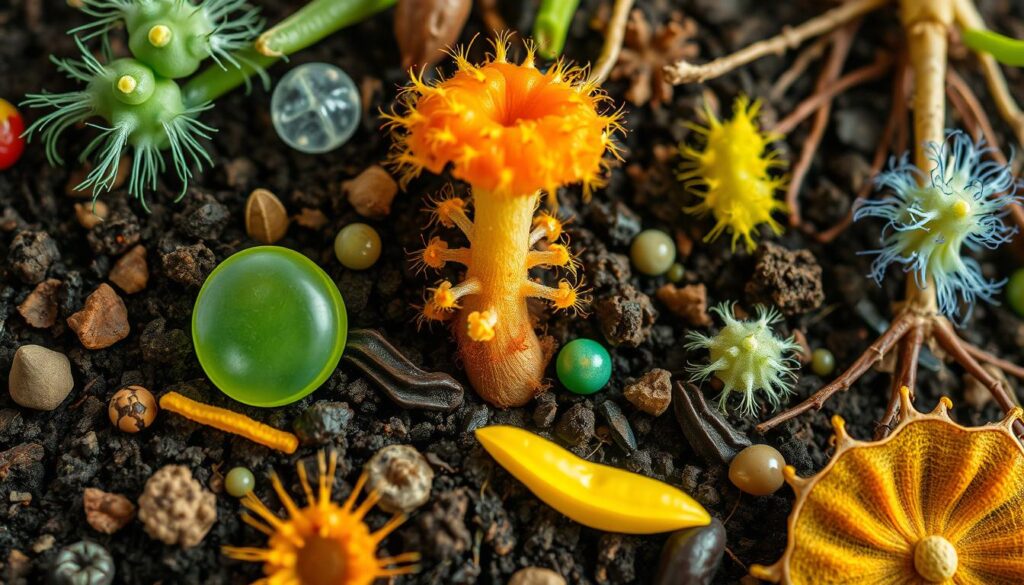
By understanding the role of soil microorganisms, we can help them thrive. This leads to healthier soils and more sustainable farming.
Building Healthy Soil Composition
Healthy soil is key for soil erosion prevention and climate-smart agriculture. It needs a mix of organic matter, minerals, and living things. Organic stuff like leaves and plant parts is very important for soil health.
To make soil healthy, we need to know what it’s made of. This includes:
- Organic matter, which can be up to 10% of soil
- Minerals like calcium, magnesium, and potassium
- Living things, such as microorganisms and worms
Using climate-smart agriculture helps a lot. Practices like growing many crops together and using cover crops improve soil. These methods boost organic matter, make soil better, and help good bugs and worms.
So, farmers can grow more food, stop soil erosion, and help our planet. This makes our food system more sustainable.
Techniques for Soil Regeneration
Soil regeneration is key in permaculture. It involves using methods to make soil healthier and more fertile. Cover crops are a top choice because they fight soil erosion and boost water quality.
Here are some main ways to regenerate soil:
- cover cropping, which involves planting crops between cycles to protect and enrich the soil
- no-till agriculture, which reduces soil disturbance and keeps organic matter
- mulching practices, which help keep soil moist and stop weeds
- composting fundamentals, which turn organic waste into a soil booster
Using these methods, farmers and gardeners can make soil better, grow more crops, and support green farming. Permaculture and regenerative agriculture are vital for keeping soils healthy and fighting climate change.
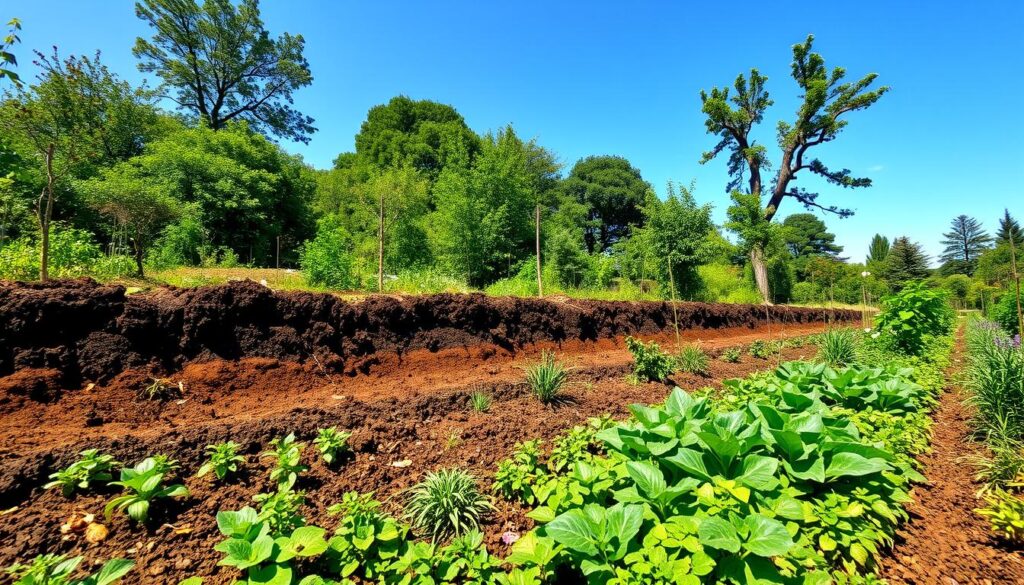
Assessing Soil Health
Soil health restoration is key to eco-friendly soil management. To do this, we need to check the soil’s current state. Soil tests help us understand its physical, chemical, and biological aspects.
These tests show us where we can improve. For instance, soil erosion rates can drop with conservation tillage and cover crops. Also, living roots and mulch boost soil organic matter, cutting down nutrient runoff.
Important things to look at when checking soil health include:
- Soil structure and composition
- Organic matter content
- pH levels and nutrient availability
- Microbial activity and biodiversity
Knowing these and using green soil management helps improve soil health.
Regular soil tests are vital for tracking progress and making smart decisions. By doing this, we help create a better future and support eco-friendly soil care.
Enhancing Soil Biodiversity
Soil biodiversity is key for healthy ecosystems. Biodiversity enhancement in agriculture can be done in many ways. One method is using natural nutrient cycling practices. This cuts down on synthetic fertilizers and boosts soil health.
Studies show permaculture areas have better soil quality and biodiversity than conventional farms. This is thanks to cover cropping, crop rotation, and mulching. These practices increase soil organic matter and support many microorganisms.
Some main benefits of improving soil biodiversity are:
- Soil structure and fertility get better
- Crops grow more and are more resilient
- More ecosystem services, like pollination and pest control
Farmers can boost biodiversity enhancement in agriculture by using regenerative practices. Reducing tillage and using organic amendments help with natural nutrient cycling. This supports a healthy, diverse soil ecosystem.
By taking these steps, farmers help make agriculture more sustainable. They also improve soil health and biodiversity.
| Practice | Benefit |
|---|---|
| Cover cropping | Reduces soil erosion and improves soil organic matter |
| Crop rotation | Enhances soil fertility and supports a diverse range of microorganisms |
| Mulching | Conserves soil moisture and suppresses weeds |
Water Management in Permaculture
Proper water management is key in permaculture. It affects the health and productivity of the ecosystem. Using efficient irrigation and preventing soil erosion are crucial. These practices help maintain a balanced and thriving environment.
Techniques like rainwater harvesting, keyline plowing, and contour mapping are effective. They help collect, store, and distribute water efficiently. This reduces soil erosion and boosts crop yields.
For instance, keyline plowing can capture up to 70% of rainfall. Contour mapping can increase water distribution efficiency by 40% on sloped land.
Swales and riparian zone restoration also improve water quality. They reduce pollutants in nearby waters. By using these methods, farmers can make their environments more resilient and sustainable.
Effective water harvesting can save 25% to 35% in irrigation needs. This is a big step towards climate-smart agriculture and preventing soil erosion.
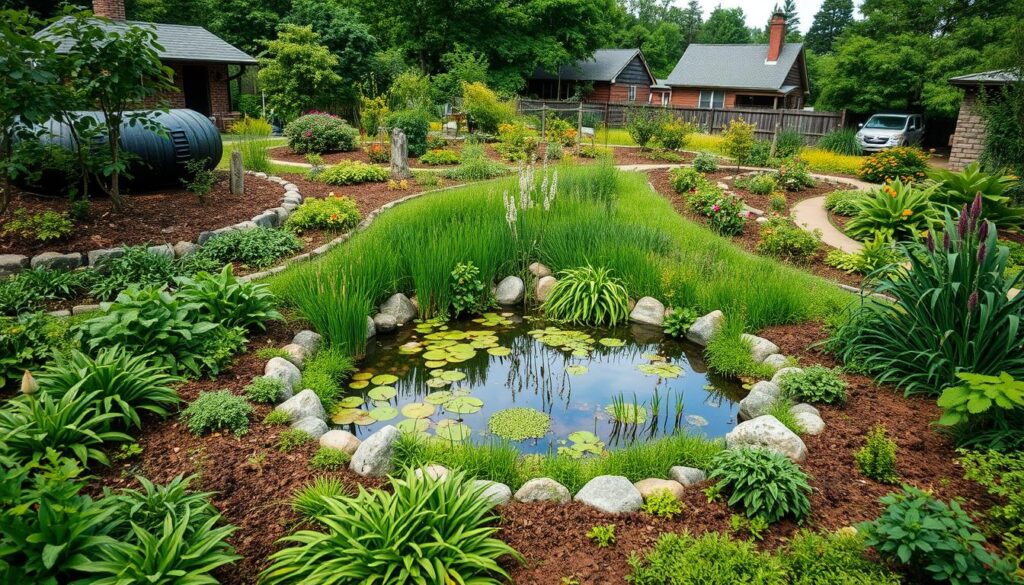
The table below shows some benefits of water management in permaculture:
| Technique | Benefit |
|---|---|
| Rainwater Harvesting | Reduces runoff by 30-50% |
| Keyline Plowing | Captures 70% of available rainfall |
| Contour Mapping | Increases efficiency in water distribution by 40% |
By using these strategies, permaculture practitioners can create sustainable environments. These environments can thrive even with climate change.
Using Native Plants for Soil Regeneration
Native plants are key in permaculture soil regeneration. They fit well with the local climate and soil. Using them helps improve soil and boosts biodiversity, vital for regenerative farming.
This method cuts down on the need for fertilizers and pesticides. It makes farming more sustainable and resilient.
Native plants offer many benefits for soil regeneration in permaculture. These include:
- Improved soil structure and fertility
- Increased biodiversity and ecosystem services
- Reduced need for external inputs and maintenance
- Enhanced aesthetic value and recreational opportunities
When picking native plants, consider the climate, soil, and use. Plants with deep roots improve soil and prevent erosion. Plants with shallow roots keep moisture and control weeds. Choosing the right plants creates a strong ecosystem that helps both people and the planet.
Gabe Brown, a leading figure in regenerative farming, says, “The secret to good soil regeneration is a diverse and strong ecosystem.” Native plants and regenerative farming methods improve soil health and biodiversity. They also support local food systems and community growth.
Incorporating Animal Systems
Animal systems are key to soil health restoration and eco-friendly soil management. Adding livestock to permaculture systems boosts soil health. Animal manure, full of nutrients, helps plants grow well.
For instance, chicken manure has about 1.1% nitrogen, 0.8% phosphorus, and 0.5% potassium. These nutrients are great for plants.
Benefits of using animal systems include:
- Pest control from animals, reducing chemical pesticide use and making ecosystems healthier
- Soil aeration and tilling from animals like pigs and chickens, making land ready for planting
- Consumption of food scraps, cutting down waste and supporting sustainability
According to permaculture practice, rotational grazing boosts forage production by 25-100% over continuous grazing. Proper composting of manure can kill harmful pathogens by up to 90%. This makes soil amendments rich in nutrients.
By adding animal systems to permaculture, we build a stronger ecosystem. It can handle extreme weather and pests better.
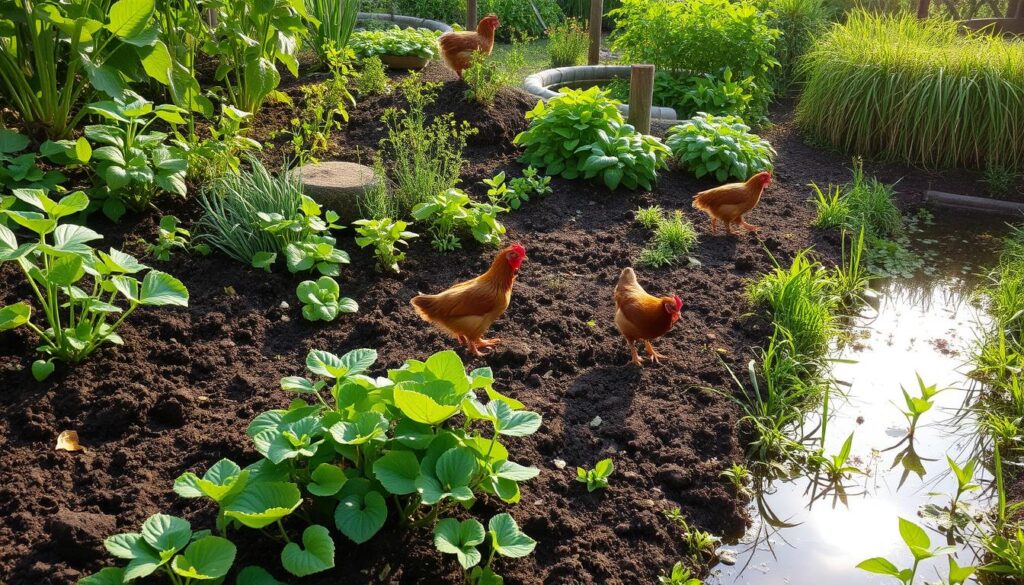
The Importance of Crop Rotation
Crop rotation is key to keeping soil healthy and boosting biodiversity in farming. It helps farmers avoid pests and diseases, improves soil, and boosts crop yields. It also helps with natural nutrient cycling, as different crops need different nutrients.
Planning and strategy are important in crop rotation. Some key things to think about include:
- Choosing crops that fit the climate and soil
- Rotating between crops that need different nutrients
- Using cover crops to improve soil and reduce erosion
By using these strategies, farmers can help biodiversity and natural nutrient cycling. This makes farming more resilient and sustainable. 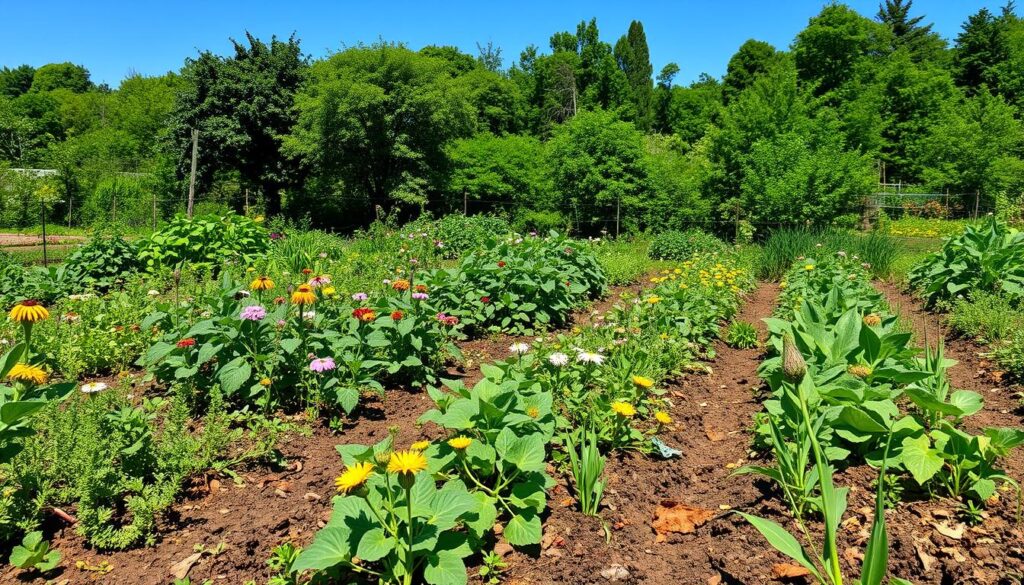
Benefits of Crop Rotation
Crop rotation has many benefits. It improves soil health, boosts crop yields, and reduces environmental harm. By using this method, farmers help make food systems more sustainable and fight climate change.
Strategies for Effective Rotation
To do effective crop rotation, farmers need to think about climate, soil, and crop choice. This way, they can make a plan that boosts biodiversity and supports nutrient cycling. This leads to more sustainable farming.
Methods for Preventing Soil Erosion
Soil erosion is a big problem in farming, with about 30–40 billion tons of topsoil lost each year. To fight this, soil erosion prevention methods are key. One good way is using plants to cover the soil, which keeps it in place and stops erosion. This is a big part of climate-smart agriculture, as it keeps the soil healthy and lowers erosion risks.
Some good ways to cut down soil erosion include:
- Contour planting: This means planting crops on a slope to lessen runoff and erosion.
- Mulching: Putting organic material on the soil surface protects it from erosion and keeps moisture in.
- Cover cropping: Growing cover crops between main crops helps keep the soil in place and cuts erosion.
These methods can work together to make a strong soil erosion prevention plan. By using these techniques, farmers can lessen soil erosion and support climate-smart agriculture.
| Technique | Description | Benefits |
|---|---|---|
| Contour planting | Planting crops across a slope | Reduces runoff and erosion |
| Mulching | Applying a layer of organic material | Protects soil from erosion and retains moisture |
| Cover cropping | Planting cover crops between crop cycles | Holds soil in place and reduces erosion |
The Role of Mycorrhizal Fungi
Mycorrhizal fungi are key in permaculture soil regeneration and regenerative agriculture methods. They work with plants to improve nutrient uptake and soil health. These fungi spread through plant roots, making it easier for plants to get nutrients from poor soil.
Some key benefits of mycorrhizal fungi include:
- Improved nutrient uptake, with fungi providing up to 80% of a plant’s phosphorus intake
- Enhanced water retention, with healthy soil structure improving water retention by up to 50%
- Increased resistance to pathogens, with endophytic fungi boosting plant resistance by more than 30%
By using mycorrhizal fungi in permaculture soil regeneration and regenerative agriculture methods, farmers can cut down on synthetic fertilizers. This makes farming more sustainable and better for the environment. It also makes the soil more fertile.
Implementing Permaculture Design
Permaculture focuses on soil health and ecosystem services. It aims for soil health restoration using eco-friendly soil management methods. This method looks at the whole ecosystem, boosting biodiversity and saving water.
Zoning is a key part of permaculture design. It divides land into sections based on how close they are to the center. This way, areas for planting, animals, and water collection are set up. It helps protect the soil from damage.
Permaculture design offers many benefits:
- It improves soil health restoration by adding organic matter and reducing soil disturbance.
- It boosts biodiversity, supporting many plant and animal species.
- It manages water well, cutting down on the need for outside water sources.
- It increases crop yields through smart planning and eco-friendly soil management.
By using permaculture design, people can help make the future more sustainable. They promote soil health restoration and eco-friendly soil management. This helps the environment and local communities.
Case Studies and Success Stories
Permaculture and regenerative agriculture have shown great success worldwide. These methods improve soil health, biodiversity, and ecosystem services. They have been used in many projects.
Some notable examples include:
- A farm in the United States that used permaculture principles to increase soil organic matter by 30% and reduce water usage by 50%.
- A community garden in Australia that implemented regenerative agriculture methods and saw a 25% increase in crop yields and a 40% reduction in pest and disease issues.
- A project in Africa that used permaculture design to restore degraded land and increase biodiversity, resulting in a 30% increase in wildlife populations.
These success stories show the power of permaculture and regenerative agriculture. They help solve environmental problems and support sustainable development.
Lessons Learned from Successful Practices
Studying these case studies, we learn important lessons. Key points include:
- Community engagement and participation are crucial in the design and implementation process.
- It’s important to plan carefully and monitor progress to fit the specific context and ecosystem.
- Combining multiple components and strategies can lead to better results and benefits.
Examples of Successful Soil Regeneration
| Project | Location | Approach | Outcomes |
|---|---|---|---|
| Farm in the United States | California | Permaculture design and regenerative agriculture methods | 30% increase in soil organic matter, 50% reduction in water usage |
| Community garden in Australia | New South Wales | Regenerative agriculture methods and permaculture principles | 25% increase in crop yields, 40% reduction in pest and disease issues |
| Project in Africa | Kenya | Permaculture design and restoration of degraded land | 30% increase in wildlife populations, improved biodiversity |
These examples show the potential of permaculture and regenerative agriculture. They promote sustainable development and address environmental challenges.
Resources for Ongoing Learning
The world of permaculture and regenerative agriculture is always evolving. It’s key to keep up with new research and methods. For those keen on biodiversity enhancement in agriculture, many resources are out there. You can find books, publications, online courses, and workshops.
Organizations like RegenAG and The Soil Foodweb Institute offer education and training. They focus on using fewer inputs and managing soil health with holistic methods. These resources highlight the role of natural nutrient cycling in soil health and biodiversity.
Recommended Resources
- Books: “The Soil Will Save Us” by Kristin Ohlson, “Regenerative Agriculture” by Gabe Brown
- Online Courses: RegenAG’s Soil Health Course, The Soil Foodweb Institute’s Soil Biology Course
- Workshops: Attend workshops and conferences by The Carbon Underground and Terra Genesis International
By using these resources, you can dive deeper into permaculture and regenerative agriculture. You’ll learn how to apply these principles. This will help you improve biodiversity enhancement in agriculture and support natural nutrient cycling in your work.
| Organization | Resource | Description |
|---|---|---|
| RegenAG | Soil Health Course | Online course covering soil health and regenerative agriculture |
| The Soil Foodweb Institute | Soil Biology Course | Online course covering soil biology and ecosystem services |
| The Carbon Underground | Workshops and Conferences | Events focused on regenerative agriculture and soil health |
Conclusion and Next Steps
Soil regeneration in permaculture is key for healthy, productive land. It helps us grow food better and care for our planet. By using permaculture and regenerative farming, we can make our soil strong again.
This guide showed us how important soil health is. We learned about soil microbes, making soil rich, and using methods like cover crops and compost. These steps help us improve our soil and support nature.
Starting a soil regeneration journey is exciting and rewarding. We suggest you start by testing your soil, trying new farming ways, or teaching others. Together, we can make our soil better and ensure a green future for all.

